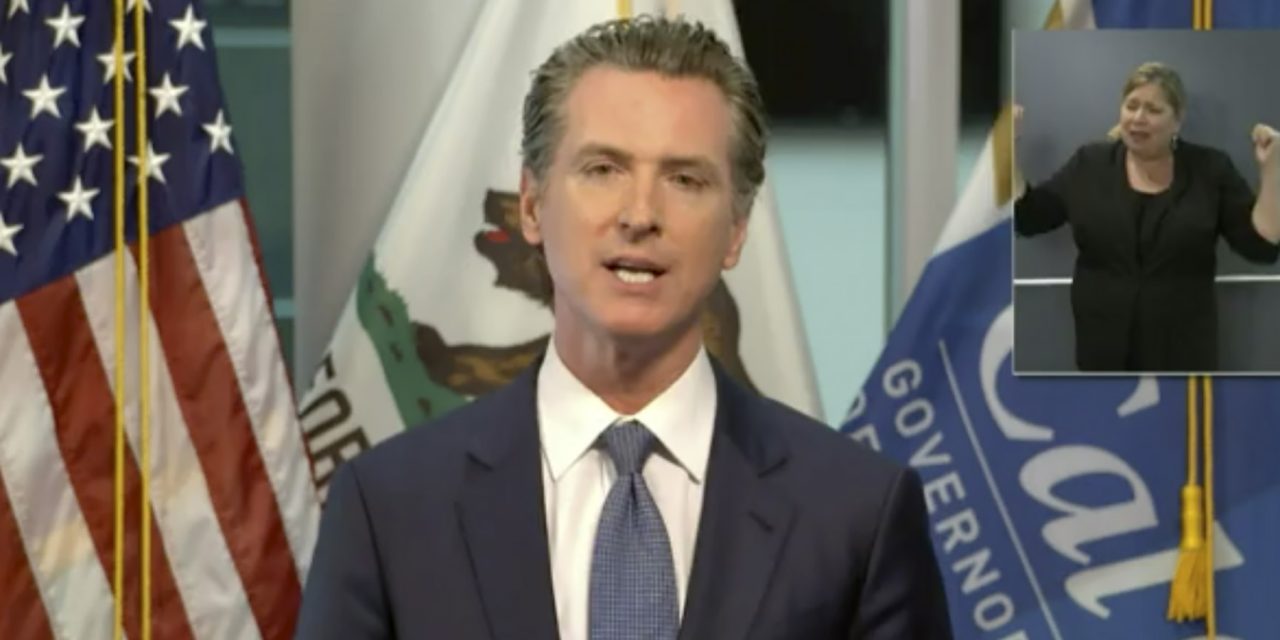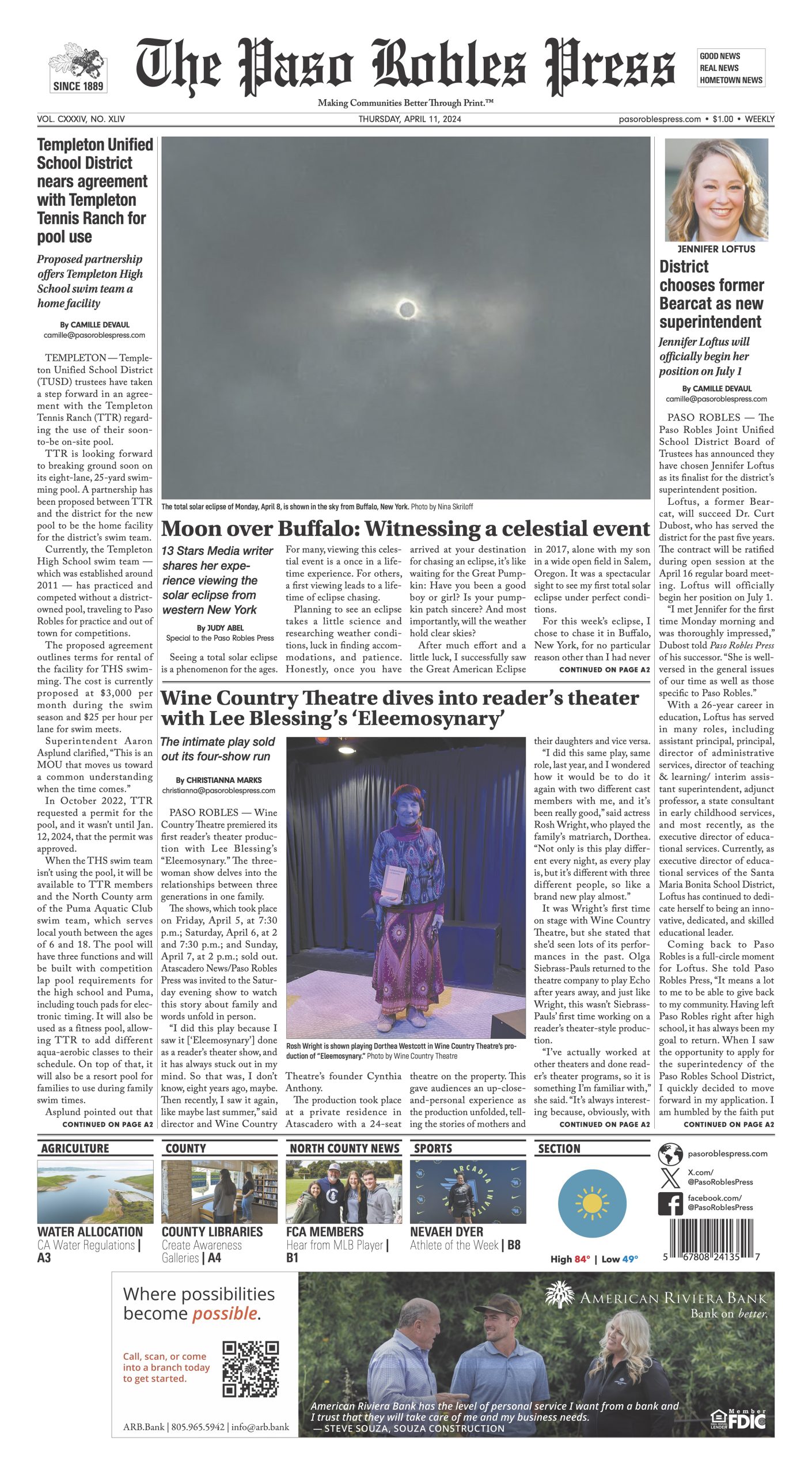Governor clarified memo sparking concerns over beaches was related just to Orange County
On Wednesday, both the Governor of California Gavin Newsom and the County of San Luis Obispo presented updated information and addressed questions from the media during independent briefings. On Thursday, Newsom followed up with another briefing, addressing concerns that had been promoted about the closing of all California beaches.
“This has been a week of some optimism,” Newsom said. “We laid out a framework for reopening in the State of California, really breaking down deeper understanding of the six indicators that will guide our decision-making.”
Newsom related today that he is working with local partners throughout the state, including elected officials and industry sector leaders to expand the definition of “essential services.” He said he is working through the state to address issues, region by region.
“It is essential that people recognize and avail themselves of physical and emotional support,” Newsom said,” and we recognize, the State of California recognizes, with its 200 parks that are still open in the State of California that there is a real need and desire to have more points of access and more points of clarification on what is allowed and what is not allowed.”
Newsom gave his public briefing in the face of backlash from reports that his office circulated a memo to law enforcement to prepare for the governmental shutdown of California beaches beginning Friday, May 1. The alleged memo made rounds on news outlets, and faced public outcry as well as letters from officials around California, including from San Diego Supervisors as well as local state Assemblyman Jordan Cunningham, which urged the State to reconsider any plans to close beaches.
Newsom spoke today to his personal feelings of disturbance about the images he saw from the weekend’s oceanside activities as thousands of people enjoyed the beaches up and down the coast of California.
“As I’ve said from day one, we have to be open to argument and interested in evidence,” Newsom said. “We can’t be driven by ideology. We have to be driven by the spread of this disease [COVID-19]. We saw a 5.2 percent in positive cases in this state. This disease has not gone away. The conditions last week that we saw on our beaches were disturbing.”
However, he did not lump all beaches or counties into that description.
“There were many outstanding examples where people met the moment, both as citizens of this state and as local leaders,” Newsom said. “I want to acknowledge that, and thank everybody for that outstanding work. That is going to get us to this goal of beginning to reopen this state sooner. But, in areas where we didn’t see that, you have to acknowledge that and own that and figure that out.”
Newsom lived up to the regional and local control he has promised over the past weeks by acknowledging that the entire state would not close beaches to the citizens, however, as a result of the local concerns witnessed in Southern California, Newsom declared the closing of certain beaches to address those concerns.
“We are going to do a hard close in that part of the state, just in the Orange County area,” Newsom said. “Specific issues on some of those beaches have raised alarm bells.”
The position taken by the State has been to ease restrictions as aggressively as possible, provide assistance where most desperately needed, and tend to issues as they arise from a local level. SLO County Administrative Officer Wade Horton had already spoken out about possible beach closures at Wednesday’s public briefing.
“Our community for the most part have done a really good job on the beach,” Horton said. “Just because there are a lot of people at the beach doesn’t mean they are closer than six feet. As far as further restrictions on the beach, we don’t want to take opportunities for people to enjoy outside.”
Horton stated the County had no plans to restrict access to the beaches in the near future, and on Thursday, the Governor supported those plans.
At the Local Level
San Luis Obispo County has taken action to produce the necessary results, based on the six indicators release by the state, to address COVID-19 at the local level, prepare for surge capacity, and take opening into its own hands — albeit at the will of the state as evidence provides local control is effective.
SLO County Health Officer Dr. Penny Borenstein presented at Wednesday’s public briefing that the residents of SLO County have accomplished the goals that have put the county on track to begin reopening.
“The reason I can sleep at night is we live in an incredible community,” Borenstein said, “and this is not about me, this is about everyone. Everyone who has been part of our county team of leaders and workers, and hundreds of county employees, city employees, people who don’t work for government who are on the front lines in oh, so many ways, and our residents who continue to comply with what we have asked them under these very terrible conditions.”
As local residents approach the 60-day mark of sheltering, limited movement, limited economy, and uncertainty, the pressure to produce a measured and effective reopening plan has come to a head — with multiple protests or rallies being organized to call for everything from more assistance and information from the government to, simply “freedom.”
“Continue to bear with us,” Borenstein said. “I’m going to talk about this plan … but I also want to acknowledge that we have the potential at this moment to be very fractured. We are hearing very different voices about what we should do. I want to ask the community to continue to go down this road together.”
Borenstein’s duty to SLO County is health. She is working hand in hand with local administrative officials, medical experts, and elected officials to help stage the reopening process, but her primary concern is the health aspect. With a mini-surge within the confines of the California Men’s Colony to an ongoing spread in Paso Robles, Borenstein leads to County to confront the spread head-on.
Most of the cases of COVID-19 are without alarm, although the rise in cases today added two hospitalizations to bring the hospital total to seven, with two of those in intensive care. As cases occur, the mild outbreaks are able to be met by the County with contact tracing and testing to prevent unknown continual spread.
“We continue to have a high percentage of people who get through this disease with either no symptoms, in some cases, or mild disease,” Borenstein said.
As was the case with the eight current cases at the CMC in San Luis Obispo. Five of the latest positive cases were of people without symptoms who were tested by default based on their contact with the other known cases. Containing the spread within confined populations is a strong focus for the County as the rest of the local population has been able to impact the spread through distancing measures.
“The areas we concern ourselves the most with are the congregate settings where this virus can spread,” Borenstein said. “We have had one more case in a skilled nursing facility. We are working with that facility in a very aggressive way to make sure that does not get out of hand.”
As cases break out in closed settings such as prisons or nursing facilities, the County engages those facilities directly, resulting in expected rises in confirmed cases as a part of stopping further spread.
“We are going to continue to ramp up testing,” Borenstein said. “As we do that, we may well see more cases as we did in this case. Five individuals with no symptoms, as a direct product of our testing everyone who might have been in the midst of this last case reported, regardless of symptoms. Don’t be surprised if we do see more cases.”
For the public population, testing will be more widely available through a partnership between the state and the county.
“Early next week, we plan to make available to the community that we will work with a state contractor to stand up testing, Monday through Friday,” Borenstein said. “It will be 12 hours per day, from 7 a.m. to 7 p.m., with one clinic in Paso Robles and one in Grover Beach.”
The County is working with the State and a company named OptumServe in order to stand up the two testing sites in the North and South SLO County. The capacity for testing is expected to be 132 daily tests within the 12 hour period at each of the sites for a total of 264. That testing is in addition to the County lab testing and private lab testing already in place.
Although the level and severity of symptoms have widened in regards to testing over the past weeks, there will continue to be guidelines for who can come for testing, where they can get tested, and testing will be appointment-based. An online portal and a phone line available to schedule appointments, and the County will release that information when the test sites are operational.
The START Guide — San Luis Obispo County’s reopening plan
The START Guide — Steps To Adapt and Reopen Together — will be released in part on Friday at the regular public briefing with Borenstein and others at the Joint Information Center in SLO.
“It will be a dynamic document, so don’t expect to go through the table of contents and find the name of your business on page 42 and figure out exactly what you need to do,” Borenstein warned. “This is going to be an ongoing dialogue with our community and refinement going forward, but it does have certain measures and components to it.”
As the Governor presents statewide information each day, the County customizes according to the state mandates as they relate to the local level.
“We are looking at three phases,” Borenstein said. “The governor talked about four — we call our first phase ‘pre-planning,’ so we think we are already in phase one. The three subsequent phases will look at what types of businesses, what types of facilities, what types of activities can resume with some continued measure of infection control, social distancing, or modifications to the way of doing business.”
Phase two is expected a minimum of 30 days after the implementation of phase one, and phase three is expected to return the county to “almost normal.” The entering into phase three’s “almost normal” circumstances could happen as soon as 60 days from the beginning of the START Guide, but Borenstein said it is dependent on the continued suppression of COVID-19 within the community at large.
With a cluster of cases at CMC, the County, not being overwhelmed by a community outbreak, was able to jump into action and test multiple people who had contact with a confirmed case and discover five people who showed no symptoms tested positive. That kind of capacity is synonymous with the “Six Indicators” introduced by the State as requirements for reopening.
San Luis Obispo County has been able to control the spread of COVID-19 significantly, compared to other counties in California, and the ability to open and function will be dependent on a community effort to maintain capacity for local healthcare to manage clusters of outbreak while the community at large operates at “almost normal” levels.
During the phased reopening, the County will be observing three sets of criteria — epidemiological criteria, healthcare criteria, and public health criteria.
Epidemiological criteria includes questions:
- How many local healthcare workers test positive?
- How much time between doubling of cases?
- Is there a rapid increase of cases over a number of days?
Healthcare criteria includes questions:
- Is the healthcare system ready to handle the level of patients that might present?
- Is there adequate personal protective equipment?
- Is there adequate bed capacity?
Public health criteria questions:
- Is there enough hand sanitizer available to allow business to operate safely?
- Are patients able to recover at home, or is the severity of the disease increasing?
“Those are some of the things we will be looking at in this guidance,” “The second component of [the SMART Guide] is … general guidelines for what businesses.”
Specifics as to what guidelines business will be required to follow in order to reopen or sustain ongoing operation are expected in the SMART Guide on Friday. Being that the goal is to provide a pathway for healthy business operation in the ongoing midst of a pandemic, the guidelines can be expected to be both considerably preventative, and not overly arduous.
Look for widespread signage about distancing, maximum occupancy, masks, hand sanitizer, and other pandemic-related information for the community.
“Still in development, sector by sector, there will be additional guidance available,” Borenstein said. “All that might not be nailed down by this Friday, but we are beginning to put down those guidances and it will be mirrored in our forthcoming modification of our legal orders about how to implement this as we move forward.”
“It is not going to be a complete and detailed plan,” “That is why we are calling the START ‘Guide.’ I don’t want people to be disappointed if they don’t see the level of detail or specificity they are hoping for. I know we have built this up, but I do want the public to understand we are hearing you, we are working with you, both through leadership and through individual comments, calls, texts, etcetera, and will continue to do that through the course of this pandemic.”










